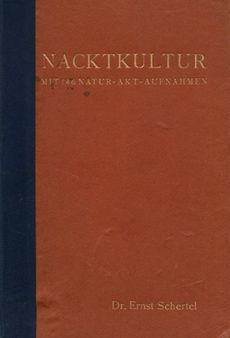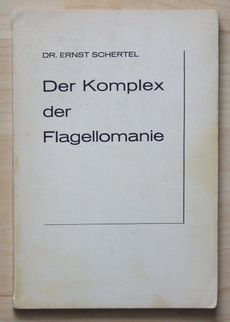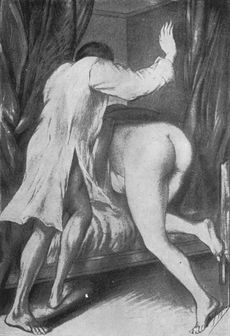Ernst Schertel
Ernst Schertel (1884 - 1958) was a German writer, historian, scholar in religious studies, and a specialist for occultism. He was also a dance pedagogue, an early promoter of nudist culture, a liberal freethinker, and a researcher of human sexuality with a particular interest in paraphilia, fetishism and sadomasochism.
There are some interesting parallels between Schertel and Aleister Crowley.
Biography
Education, first writings and dance pedagogy
Ernst Schertel studied history and philosophy in Jena. In 1911 he received his PhD magna cum laude with the dissertation "Schellings Metaphysik der Persönlichkeit" at Jena University. After writing his first novel, Die Sünde des Ewigen oder Dies ist mein Leib (1912/1913), Schertel, aged 30, began his career during World War I as a teacher in one of Germany's leading progressive schools, Freie Schulgemeinde Wickersdorf, where he taught German, Old History and Religious History. At the same time he developed his own dance pedagogy that involved music composed by himself and trance, making use of means such as hypnosis, incense and alcaloids, designed to promote a liberated approach to the body and sexuality. After leaving the institution (due to what was seen as a too positive view of homosexuality), he founded his own dance schools to continue his methods.
1920-1933
In the 1920s and 1930s Schertel became a central figure in the German Nacktkultur (nudist culture) movement, which also had ties with the fetishist and BDSM culture of the time. He also supported other social causes such as the decriminalization of homosexuality and abortion. In addition, he grew a strong interest in occultism. In 1922 he wrote the screenplay of the silent film Das Blut der Schwester "with a macabre story combining horror, incest, science fiction, and crime-thriller imagery."[1]
In 1926, Schertel began to work intensively as a researcher, writer and publicist. He published two magazines, "Soma" and "Asa", that focused on eroticism and occultism. He also wrote books published by Parthenon-Verlag in Leipzig, including volumes of nude art featuring photographs taken by Schertel himself. Parthenon-Verlag was "perhaps the most daring and erotically conscious promoter of Nacktkultur until 1933."[2] From 1929 to 1932, he published his magnum opus, Der Flagellantismus als literarisches Motiv in which he presents and discusses in great detail the motif of flagellation (with a strong spotlight on spanking) in art and literature.
Other related publications from that period:
- 340 mal "Thema eins" in Wort und Bild. Sitte und Sünde. Eine Sittengeschichte im Querschnitt (1930, reprinted 1967)
- Der Komplex der Flagellomanie (2 volumes, 1930, reprinted 1970)
- Flagellantismus und Gesetz. Eine Kampf- und Verteidigungsschrift (1931)
- Der erotische Komplex. Untersuchungen zum Problem der paranormalen Erotik in Leben, Literatur und Bildnerei, Pergamon (1932, reprinted c. 1970)
- Fetisch und Fantasie (1933, reprinted c. 1968, 1980)
During that period, together with Parthenon-Verlag and supported by Magnus Hirschfeld and Fedor von Zobeltitz, Schertel fought against the censorship of erotic topics in publications. Schertel corresponded with leading psychoanalysts such as Sigmund Freud and Wilhelm Stekel, and held speeches on conventions.
1933-1945
Schertel's scientific and publicist activities came to an abrupt end in 1933 when the Nazis took power. Schertel fled to Paris but returned to Germany in 1934, where he was arrested on the claim of having published obscenity. He was sentenced to seven months imprisonment. The Nazi government put all of Schertel's works and all publications of Parthenon-Verlag on the index of forbidden media. In 1937, Jena University divested him of his doctorate. Until the end of the Nazi rule, Schertel made his living as a lector and corrector of "harmless" fiction.
1945-1958
After the end of World War II, Schertel, aged 61, began to write again, but with lesser success and mainly on esoteric topics and religious history. His attempts to publish anything explicitly sadomasochistic failed due to the prudish spirit of postwar Europe (the same that also put an end to early 20th century French spanking literature which had blossomed before the war). Schertel did succeed, though, in publishing a revised edition of his magnum opus under the title Der Flagellantismus in Literatur und Bildnerei (1957). This new editon was only available on subscription for personal and scientific use, not to the general public.
Schertel died on 30 January 1958 from a heart attack.
Ernst Schertel and spanking art
Schertel was one of the first persons in history who took a serious scientific interest in the genre of spanking literature and spanking art. In the 1920s he tirelessly collected material on this topic, sorted and categorized it, and made his own theories to explain the various characteristics and phenomena observed.
Schertel's greatest value, though, were possibly not so much his scientific conclusions (which are often regarded as only "semi-scientific"), but the fact that he was not afraid of publishing explicit sexual and paraphilic subject matter despite the looming threat of social and legal trouble. His largely objective discussion of the BDSM/spanking culture of his time and his fight for free speech and free artistic expression helped the BDSM and spanking culture and their artistic and literary forms of expression to find wider acceptance in parts of society.
Little is known about Schertel's private life, and it is not known whether Schertel was a fetishist, sadomasochist or spankophile himself. He maintains a distant and analytical point of view in his books, but the intensity of his research in these topics seems to suggest strong personal interest.
See also
References
External links
Chat rooms • What links here • Copyright info • Contact information • Category:Root


